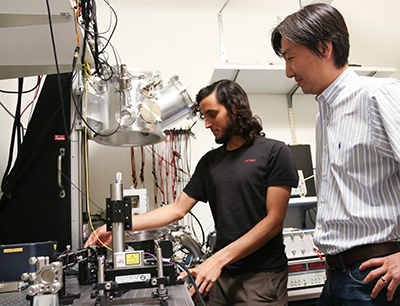Congratulations to University of Utah Mechanical Engineering Ph.D. student Amun Jarzembski for receiving the National Science Foundation Graduate Research Fellowship. Amun, advised by Prof. Kay Park, will conduct research on near-field thermal radiation. The NSF GRF will support Amun’s Ph.D. work for three years.
Amun’s research involves the exploration of near-field thermal radiation from a nanoscale heated tip to planar substrate for sub-10nm gaps. Since the discovery that near-field thermal radiation can exceed Planck’s blackbody limit by several orders of magnitude, experimental and theoretical studies of its spectrum and gap dependence have become crucial to the understanding of waste heat energy conversion devices, nanoscale thermal management systems, and sub-continuum heat transfer. The use of a heated tip allows for simultaneous measurement of absorbed and scattered thermal radiation which enables spectroscopic measurements. His research aims to fundamentally understand the infrared (IR) light-matter interactions that govern the spectral and absorbed near-field thermal radiation for varying gaps and materials.
Objectives of this project:
- Determine the gap dependence of absorbed near-field thermal radiation to sub-10nm gap regime.
- Measure the spectrum of tip-scattered near-field thermal radiation for various materials.
- Directly measure the spectrum of near-field thermal radiation and compare with the corresponding tip-scattered spectrum.
To conduct this research, Amun will leverage expertise and resources from Dr. Kay Park’s Micro/nanoscale Energy Transport and Conversion Lab (METCL), which has an ultra-high vacuum atomic force microscop (AFM) with scattering-type scanning near-field optical microscopy capabilities. This optical AFM allows for atomic resolution topographic and nanoscale optical microscopy. Additionally, the lab is equipped with a tunable mid-IR laser source that provides the ability to perform nanoscale mid-IR microscopy and spectroscopy. This combination of instruments puts the METCL lab in the unique position to conduct tip-based near-field thermal radiation experiments to comprehensively understand nanoscale radiative phenomenon.
Additional milestones of this research include near-field opto-thermal measurements for the determination of nanoscale temperature distributions, nanoscale IR spectroscopy for material characterization, and near-field photocurrent measurement on thin film solar cells.

Amun graduated from the University of Alabama in Huntsville (UAH) with a bachelor’s degree in mechanical engineering and received their Most Outstanding Undergraduate Mechanical Engineering Student Award. While at UAH, he participated in several student driven projects and worked on radar systems for Raytheon Huntsville. His fascination with the thermal sciences began when he designed an algorithm to compute building heat transfer for a residential house based on local weather and solar data. However, being the son of two NASA physicists who specialized in optics and lasers, inherently he found the most fascination with energy carried by radiation. When Dr. Park provided the opportunity for him to build up a nanoscale optics lab with focus on thermal radiation and energy conversion, he knew the fit was too perfect!
Outside of academics, he is an avid musician who composes progressive orchestral music and fluently plays electric guitar. His debut orchestral album, “Sound Waves of an Echo,” can be found on Amazon, iTunes, etc. He also loves spending time with his family and friends in the beautiful Utah mountains, skiing, backpacking, and climbing.
Through the NSF Graduate Research Fellowship, Amun will have the financial support of the National Science Foundation including an annual stipend of $34,000 and a $12,000 cost of education allowance for tuition and fees. He also will have access to special opportunities for international research and professional development, and the freedom to conduct their own research at any accredited U.S. institution of graduate education they choose (nsfgrfp.org/general_resources/about).